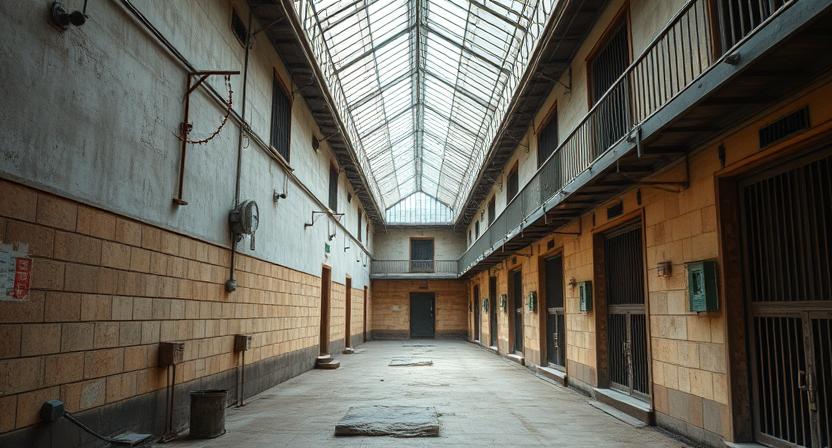- About Us
- Legal Services
- Family Law
- Property
- Marriage
- Immigration
- Contact
- Payments
Life Inside Thailand’s Immigration Detention Center (IDC). The IDC in Bangkok with its holding facilitates around the country is where deportation starts. Everyone is deported from Bangkok under the authority of the Immigration Act B.E. 2522 (1979) and relevant Ministerial Regulations issued by the Ministry of Interior.
The IDC is seen as an administrative measure and not part of criminal punishment. The people who are detained at the Immigration Detention Center are those are are either stateless or have overstayed their visas. Those who have entered the country illegally are also held here.Even criminals who have now been released got to the IDC for deportation. We will cover the legal foundations as well as the rights of detainees as well as the conditions in the center. Likewise also see the immigration legal services Thailand on here. Lastly also see the visa overstay fee Thailand as well. This is what life inside IDC Bangkok is like.

Under Section 54 of the Immigration Act B.E. 2522, immigration officers are empowered to detain any foreigner subject to deportation until arrangements for removal are completed. The section provides:
“Any alien ordered to be deported under this Act may be detained in custody until such time as the deportation can be effected.”
The provision grants broad administrative discretion to the Immigration Bureau of the Royal Thai Police, which supervises all detention facilities related to immigration enforcement.
You will note that detention under Section 54 of the Act is not punitive in nature; it is administrative detention for the purpose of ensuring deportation. However, in practice, detainees may be confined for extended periods this can be in some cases, be months or years. Where the deportation is delayed by a lack of proper paperwork or where there are diplomatic disputes.
The Immigration Detention Center in Bangkok operates under the Immigration Bureau, Division 3.This with coordination from the Department of Consular Affairs and foreign embassies. Likewise all oversight, however, remains limited; judicial review of detention is minimal, and detainees cannot easily challenge the legality or duration of their custody.
This is what life inside IDC Bangkok is like. The IDC houses a diverse population with distinct legal statuses:
Visa Overstayers: The largest group in the IDC are over-stayers. These are people who have been arrested or surrendered for overstaying their stay.
Illegal immigrants: These people tend to be mainly Burmese who have entered Thailand without valid passports or through irregular border crossings.
Persons Awaiting Deportation after Criminal Convictions: The smallest group tends to be offenders transferred from a Thai prison upon completion of sentences and are now subject to deportation.
Refugees: These are individuals seeking recognition under the UNHCR mandate. They are often held until they have settled in a third country.
Stateless Migrants: These people have no recognized nationality. This makes them impossible to deport. These tend to make up the long term stayers.
This heterogeneity creates administrative challenges, as different legal and humanitarian considerations apply to each group.
The Bangkok IDC is located on Soi Suan Phlu, Sathorn District. The IDC was built with cells to accommodate detainees in very confined space. This is life inside IDC Bangkok.
The facility comprises multi-tiered cells accommodating dozens of detainees in confined spaces. Independent reports and embassy observations note chronic overcrowding, limited ventilation, and restricted access to outdoor areas. Sleeping mats line the floors, and privacy is virtually nonexistent.
Regional IDCs in Chiang Mai, Songkhla, and Phuket vary in condition but face similar structural limitations.
Detainees follow a regimented schedule managed by immigration officers. Typical daily routines include:
Morning Roll Call: Verification of detainee numbers and identification.
Meal Distribution: The detainees get basic Thai food. This is provided three times daily. If you are looking for a special diet, this would be rare.
Limited Recreation: They have short outdoor periods in the Bangkok IDC while under supervision.
Health Checks: This is conducted a bit sporadically by visiting medical staff from the Ministry of Public Health or from the volunteer NGOs.
Much like a prison, communication is restricted. Detainees may use phones during designated times or through embassy-arranged calls, but access to the internet and media is prohibited. This is life inside IDC Bangkok
As noted above health services are available but limited. The most common concerns at the IDC include malnutrition, skin infections, and communicable diseases such as tuberculosis. Medical NGOs such as the International Organization for Migration (IOM) and Jesuit Refugee Service (JRS) provide periodic humanitarian assistance and medical referrals.
As stated before, that the immigration detention is administrative. The detainees do retain certain legal rights under Thai law as well as under international norms. This is life inside IDC Bangkok.
Likewise under the Vienna Convention on Consular Relations (1963), to which Thailand is a party. The Thai government must notify foreign detainees’ embassies upon request. Most embassies in Thailand maintain a contact lists and provide welfare checks.
Even though detainees have a right to legal counsel. You will note that access is constrained. This as the Immigration Act does not guarantee automatic assignment of lawyers.
Likewise under Thailand’s obligations under the Convention against Torture (CAT) as well as under customary international law. These impose duties to treat all detainees humanely and prohibit indefinite or arbitrary detention.
Thailand does not have a formal system for periodic judicial review of immigration detention. However, detainees may petition the Administrative Court or seek habeas corpus relief in rare circumstances. The wide discretion under Section 54 makes this pointless. This is life inside IDC Bangkok.
The Embassies in Bangkok help to identified their nationals as detainees, They will be the first stop for an Emergency Travel Documents (ETDs). They will usually help with repatriation of their detainees. As soon as they can issue a travel document and you can arrange for a flight. The detention will be short.
Depending on your country sometimes consular staff visit detainees. They usually needed things such as toiletries. Likewise providing families with updates. The frequency of such visits will vary. This depending on embassy resources and detainee numbers. So don’t hold your breath.
Likewise once travel documentation is confirmed. The embassy coordinates with the Immigration Bureau’s Deportation Division to secure flight arrangements as well as escort officers as well as the exit formalities. Costs may be borne by the detainee, family, or embassy. As stated on this website before. You will only be uncuffed once you are on the plane. This is life inside IDC Bangkok.
There are a number of international agencies which you can find around the IDC.
IOM (International Organization for Migration): They tend to provide medical screening as well as assisting people with voluntary return for detainees.
JRS (Jesuit Refugee Service): They ten to offer detainees legal aid where needed for such things as bail application. Note that they tend to help asylum seekers.
UNHCR: They offer help where detainees are stateless people and monitor refugee status. They tend to advocate for easier or no detention.
Thai Red Cross: Provides medical and nutritional support during emergencies.
These organizations all operate under a Memoranda of Understanding (MOUs) with the Thai government. Thus they balance humanitarian outreach with the laws of the country.
If you are a stateless person you can be held indefinitely at the IDC. They do have many of these long term detainees. This because the Immigration Act allows detention “until deportation can be effected,”. so there is no legal limit as to how long you can be held. So you can be help with indefinite detention.
With proper legal assistance and under certain cases. Thai immigration may approve temporary release under Section 47 upon the posting of a security bond or guarantee. This is mainly for people waiting for documents for their Embassy.
Loads of reform discussions which has been led by the Thai Ministry of Justice and UN agencies have promoted community-based alternatives for vulnerable groups. This mainly aimed at children, women, and refugees. Pilot programs now allow limited supervised release under the ATD (Alternatives to Detention) Program initiated in 2019.
Like mots prisons the IDC consistently operates beyond capacity. There is simply not enough space at the IDC for the amount of people they detain. By some estimates the IDC is overcrowded by at least 300%. This created sanitation problems as well a disease transmissions. This is life inside IDC Bangkok.
There has been criticism by the UN Human Rights Committee and NGOs for indefinite detention. People mainly the stateless persons from Myanmar will be held for years.
There are special risk for women, children, and refugees. Although minors are technically detain-able, Thailand has adopted non-detention policies for children since 2019, emphasizing family and community placement. Implementation, however, remains uneven.
Lastly independent monitoring is limited. Likewise access for journalists and civil society is tightly controlled. Most information about conditions originates from embassy reports, NGO and detainees themselves once released.
